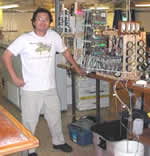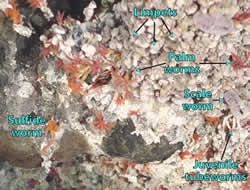|

Teacher's Report
Bill Hanshumaker, Educator at Sea
| |

Dr. Ray Lee stand beside his experimental
apparatus, which he designed for simulating the deep sea environment.
He uses the apparatus to study how hydrothermal animals respond to
stress. |
Researcher Interview:
Ray Lee
Assistant Professor
School of Biological Sciences
Washington State University at Pullman
Bill:
Tell me something about the research that you are conducting here on the
Thompson.
Ray:
Physiology is the science dealing with the functions and
vital processes of living organisms. I'm an environmental physiologist
interested in how animals respond to stress. Hydrothermal vents are perfect
sites for studying stress because they are potentially toxic, high-temperature
environments with rapid fluctuations. What we see at the vents is a gradation
of different microenvironments with different intensities and different
species of animals living there. For example, the sulfide worm is found
in the hottest environment. Is this because the sulfide worm has higher
tolerance to heat, or because it is being excluded from other areas due
to biological competition?
Bill:
Can you tell us something about your experimental apparatus?

Sulfide
worms, palm worms, juvenile tubeworms, and scale worms with bacteria
on their scales all live upon a mass of limpets, mucus and bacteria.
(Click for full-size). |
|
Ray:
On this cruise we are using two different types of setups.
One is for behavioral studies. We put animals into a thermal gradient
under pressure, because you can't get valid experiments unless the animals
are studied under their normal living conditions. In this case it is high
pressure, over 2000 pounds per square inch! So we put them in specially
designed chambers and vary the temperature. The other setup involves physiological
measurements of respiration. We put the animals in pressure chambers under
different temperatures and see how it affects their physiology. Generally,
in nature when you increase the temperature, the animal's metabolism increases.
Usually this means that the animal would need more food. So one question
is: Do animals that are normally found in hotter environments exhibit
lower effects of temperature? Do you see less of an increase in rates
of metabolism compared to animals found in cooler environments?
Bill:
How are you measuring these changes in metabolism?
Ray:
Metabolic rates are correlated to oxygen consumption. The higher the
metabolism the more oxygen that is consumed. I determine this by
measuring the oxygen level of the water before and after it flows into
the pressure chambers with the animals. We have automated analysis
equipment that can measure that.
Bill:
Can you tell us something about the animals that you are using in this
study?
Ray:
Mostly what I'm focusing on are the high-temperature animals that live
in different thermal regimes. There's the sulfide worm, Paralvinella sulfincola
that seems prefers extremely hot water, and the palm worm, Paravinella
palmiformis that seems to prefer cooler water.
Bill:
What is the temperature range?
Ray:
That's controversial. Some observations have suggested
that they can live in 60-degree Celsius (C) (140 F) temperatures, with
spikes up to 80°C (176°
F). But this is contradictory to the biochemical evidence that suggests
the enzymes and proteins of the animal are not functional at that extreme
temperature. The only way to really know what the animal can tolerate
is to study them under known conditions. Last year I showed that they
die at about 50° C (122°
F). I think that 50 degrees is their thermal limit, and that they prefer
temperatures under 45° C (113°
F).
Bill:
What ramifications do you see for the results of your research?
Ray:
On a smaller scale, there have been ecological studies of vent
communities without a sense of the physiological aspects. For example:
animal recruitment, distribution or species succession could be due to
biotic factors such as competition or food availability; or it could be
due to abiotic factors like water chemistry or temperature.
Understanding the impact of the abiotic components is one thing that can
be addressed by physiological studies. On a broader scale, these vent
animals are unlike the typical laboratory animals such as the white rat.
If we only study animals that we can maintain in the lab, then we are
biasing our whole understanding of physiology. For example, we can use
the rat model to infer the biology of a deep-sea organism, but can't
necessary know that. We are developing the technology to study animals
that live under extreme environments.
Fundamental biology, like how hemoglobin works, is based on laboratory
animals such as rats. But rats are highly evolved and specialized
animals, and don't necessarily represent what happened in early earth
history. Earth's initial atmosphere didn't contain oxygen. The sulfide
worm is more representative of the type of animals that have been on
earth much longer than rats. Tubeworm hemoglobin also binds hydrogen
sulfide, which was present in the early earth's atmosphere. Hemoglobin
predates oxygen, so if you what to study how hemoglobin evolved, using
animals such as the sulfide worm may provide interesting insights.
Knowing why essential molecules such as hemoglobin work the way they do,
can be more important than just understanding how they work.
|

